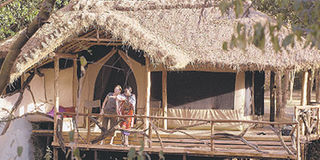Nurturing Naboisho

It’s been an exciting day for the Base camp team and we’re returning from Ol Sere in Naboisho conservancy where we have spent the day with more than 300 Maasai who have come together to form the Naboisho conservancy which borders the world famous Maasai Mara, home to the annual migration of the wildebeest from the Serengeti in Tanzania.
Despite the sun and the rain during the day, more than eighty per cent of the landowners turn up to sign leases for one of the biggest conservancies in the Mara – 20,000 hectares.
The excitement is palatable because this pristine land so rich with forests, plains, hills and wildlife is now a secure wildlife haven where the local Maasai can still manage their daily lifestyle like herding their cattle and sending the kids to school without having to forgo tradition and it opens borders without fences with the Mara for the animals to migrate.
“Naboisho means coming together in Maa,” explains Judy Gona-Kepha the CEO of Basecamp Foundation.
The first lease is for 15 years.
With the afternoon rain, the black cotton soil is soaked and slippery and in the darkness, one car loses track and ends up lost. The cell-phone comes in handy and soon we’re driving slowly to rescue it.
A cache of spotted hyenas materialises out of the darkness to await a bounty. They must be sorely disappointed when the cars drive away.
The sighting is good news that there’s a healthy population of spotted hyenas in the conservancy where, in other places, populations have declined to such drastic numbers in Kenya that they are almost locally extinct in those places. according to the National Large Carnivore Conservation Strategies launched by the Kenya Wildlife Service (KWS) this year.
“You will see so much wildlife in the conservancy,” promises John M. Saruni the Base camp community projects officer as we drive out from the camp Mara to Wilderness Camp, a stunning Maasai-owned lodge run by Base camp Explorer on the edge of a buff overlooking an ethereal landscape of acacia woodland with the seasonal Koiyaki river flowing past.
A large herd of the dull grey animals mingle with the zebra on a vast plain that’s endless. It’s not the wildebeest migration but the resident herd.
I’ve already ticked off a herd of elephants with the young, a flock of the migrant European storks and the intra-migrant flock of Abdims storks plus seen the bejeweled Malachite kingfishers flit in a bush by the river.
There are herds of Thomson’s gazelles, the larger Grant’s gazelles and copper-red impalas everywhere. Seasonal pools of waters ripple in every depression with birds of the wetlands like the geese and ducks.
I can’t remember the last time I saw herds of giraffes of such magnitude. Turning a bend in the track, tall necks appear by the grove of yellow fever trees – some standing, some sitting and many mothers with their young.
It’s definitely a nursery and John and I count up to 40. I think it’s a great sighting but we’re in for more – another herd of 100!
“This morning, we saw a pride of lions by the Koiyaki Guide School,” says John. The school near the Wilderness Camp is the only education centre in Kenya providing guide training focused on the Masai Mara.
There’s a joke about Moses Ole Sayalel of Base camp and the African ambassador who visited Daramsala the abode of the Dalai Lama in India and had the privilege of meeting him.
He presented him with a photograph by Ole Brent Froshaug, the man who started Base camp Foundation with a strong philosophy of leaving a positive footprint.
Today, Base camp Foundation operates a series of Base camp Explorer camps and lodges in India, Europe and Asia with the Ice Ship in the Arctic.
“None of us knew what the picture was about,” narrates Lars Lindkvist, the executive chairman of Base camp Foundation Kenya.
“Moses unwrapped it and it was one of the Naboisho lions with blood on his face gorging on a buffalo lying by him.
Quick to the cue, Moses quipped to the Dalai Lama, a vegetarian, “Your Highness, this is a non-vegetarian lion.”
Email: [email protected]




